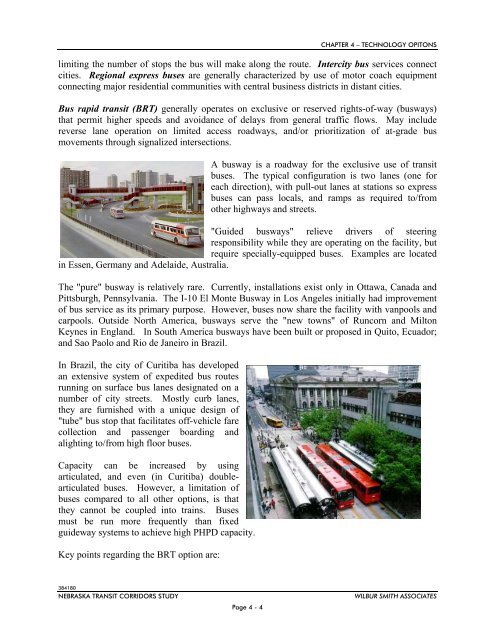NTRAC Final Study - Nebraska Department of Roads - State of ...
NTRAC Final Study - Nebraska Department of Roads - State of ...
NTRAC Final Study - Nebraska Department of Roads - State of ...
You also want an ePaper? Increase the reach of your titles
YUMPU automatically turns print PDFs into web optimized ePapers that Google loves.
CHAPTER 4 – TECHNOLOGY OPITONS<br />
limiting the number <strong>of</strong> stops the bus will make along the route. Intercity bus services connect<br />
cities. Regional express buses are generally characterized by use <strong>of</strong> motor coach equipment<br />
connecting major residential communities with central business districts in distant cities.<br />
Bus rapid transit (BRT) generally operates on exclusive or reserved rights-<strong>of</strong>-way (busways)<br />
that permit higher speeds and avoidance <strong>of</strong> delays from general traffic flows. May include<br />
reverse lane operation on limited access roadways, and/or prioritization <strong>of</strong> at-grade bus<br />
movements through signalized intersections.<br />
A busway is a roadway for the exclusive use <strong>of</strong> transit<br />
buses. The typical configuration is two lanes (one for<br />
each direction), with pull-out lanes at stations so express<br />
buses can pass locals, and ramps as required to/from<br />
other highways and streets.<br />
"Guided busways" relieve drivers <strong>of</strong> steering<br />
responsibility while they are operating on the facility, but<br />
require specially-equipped buses. Examples are located<br />
in Essen, Germany and Adelaide, Australia.<br />
The "pure" busway is relatively rare. Currently, installations exist only in Ottawa, Canada and<br />
Pittsburgh, Pennsylvania. The I-10 El Monte Busway in Los Angeles initially had improvement<br />
<strong>of</strong> bus service as its primary purpose. However, buses now share the facility with vanpools and<br />
carpools. Outside North America, busways serve the "new towns" <strong>of</strong> Runcorn and Milton<br />
Keynes in England. In South America busways have been built or proposed in Quito, Ecuador;<br />
and Sao Paolo and Rio de Janeiro in Brazil.<br />
In Brazil, the city <strong>of</strong> Curitiba has developed<br />
an extensive system <strong>of</strong> expedited bus routes<br />
running on surface bus lanes designated on a<br />
number <strong>of</strong> city streets. Mostly curb lanes,<br />
they are furnished with a unique design <strong>of</strong><br />
"tube" bus stop that facilitates <strong>of</strong>f-vehicle fare<br />
collection and passenger boarding and<br />
alighting to/from high floor buses.<br />
Capacity can be increased by using<br />
articulated, and even (in Curitiba) doublearticulated<br />
buses. However, a limitation <strong>of</strong><br />
buses compared to all other options, is that<br />
they cannot be coupled into trains. Buses<br />
must be run more frequently than fixed<br />
guideway systems to achieve high PHPD capacity.<br />
Key points regarding the BRT option are:<br />
384180<br />
NEBRASKA TRANSIT CORRIDORS STUDY<br />
Page 4 - 4<br />
WILBUR SMITH ASSOCIATES

















